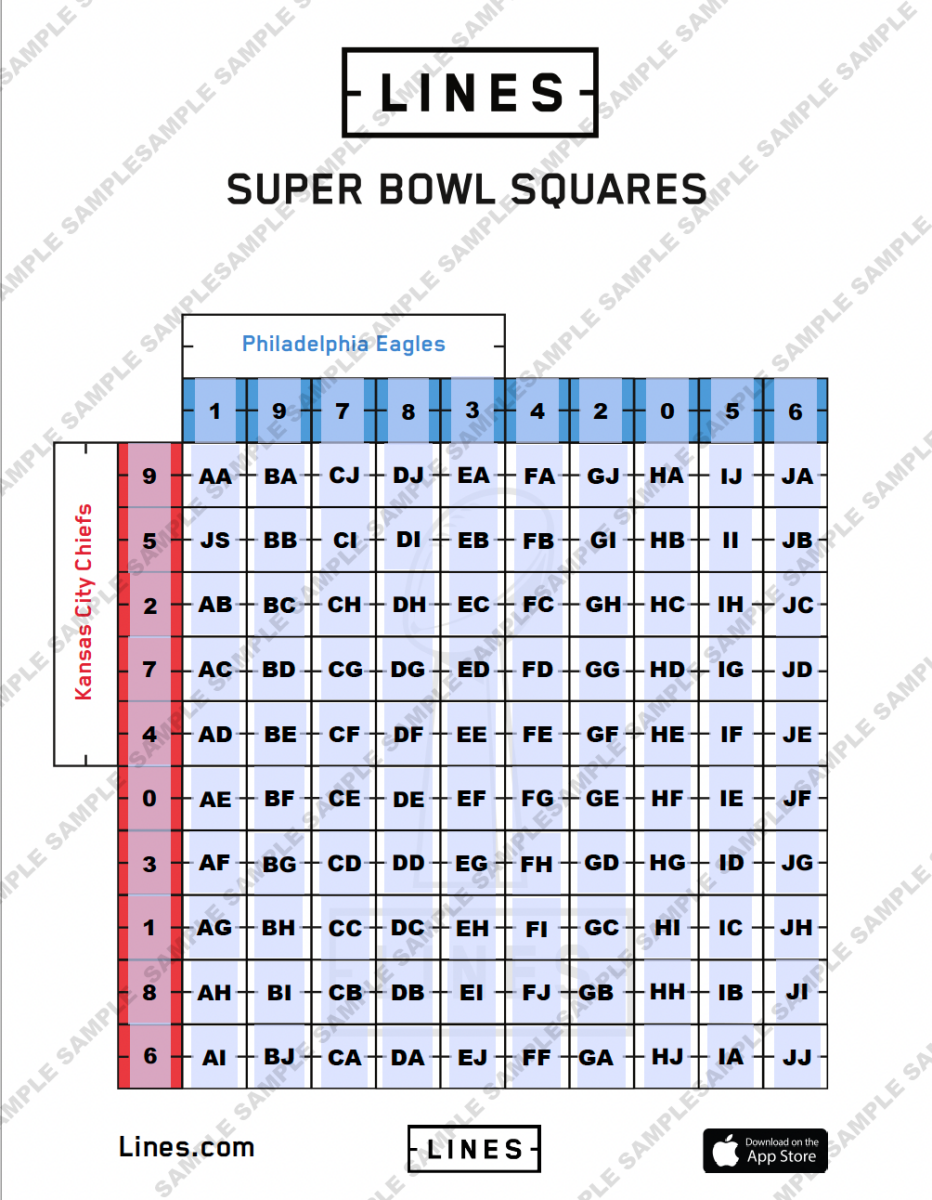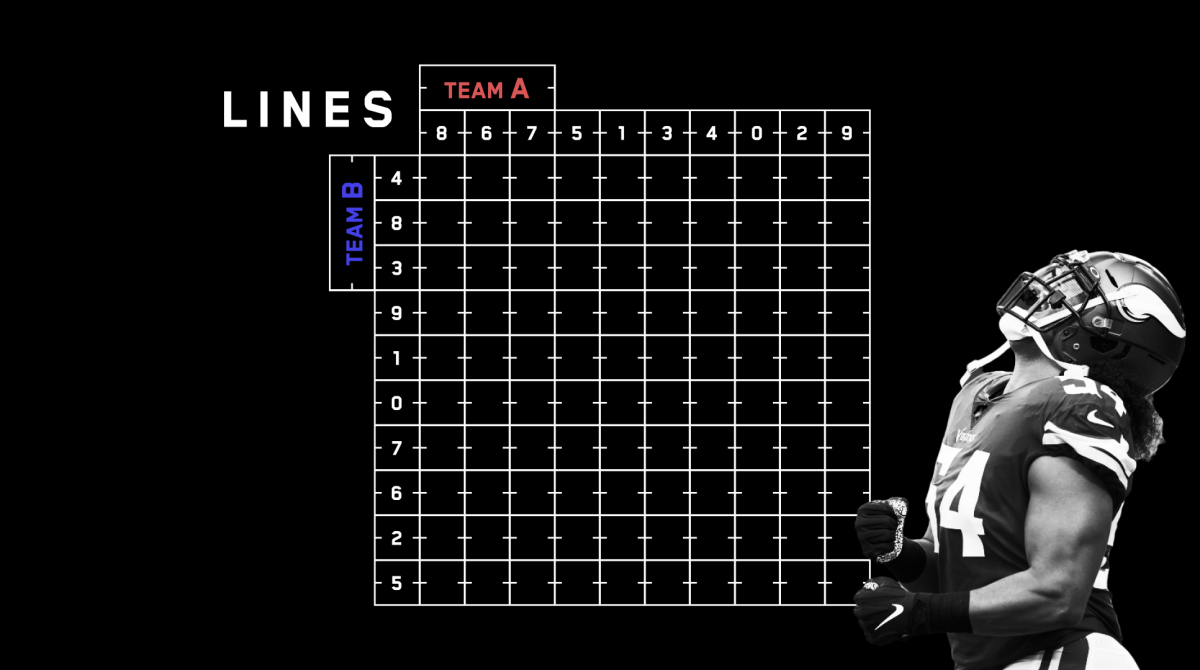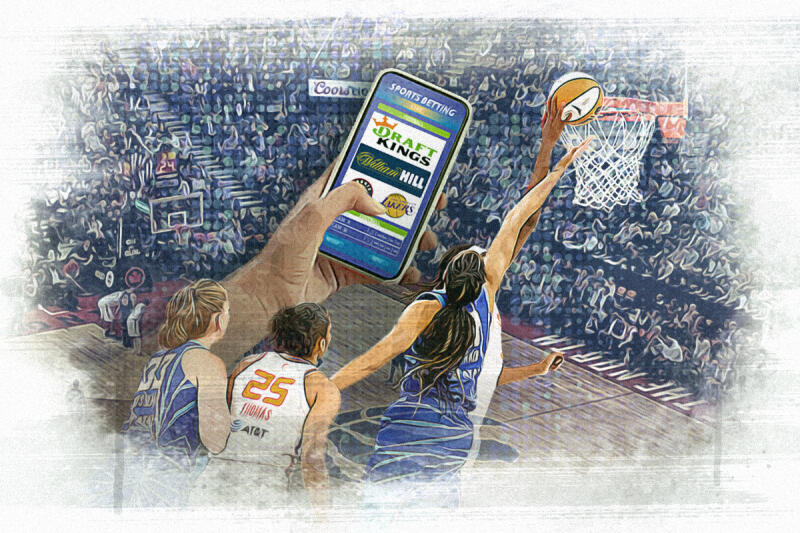How Do Super Bowl Squares Work?
Super Bowl squares gives all fans of the big event a chance for wager-tainment, whether they are hard-core fans or not. As a matter of fact, it is one of the best ways for non-experts to get involved. Whether you can recite every past Super Bowl winner or you are more interested in the halftime performance, you have an equal chance of winning your Super Bowl squares entry. At the end of each quarter, you want to have the square that matches up with the last digit in each team’s score. Same thing holds for the final score.
Related: Super Bowl Odds 58
How to Play Super Bowl Squares
It is always fun to play Super Bowl Squares. Each player receives a board with 10 columns and 10 rows that intersect. This gives them a total of 100 squares. The columns are associated with one of the Super Bowl participants and the rows to the other. The numbers from zero to nine are then randomly selected for each row or column. This allows for any possible score combination.
The pool that you enter will determine who gets which squares. Some pools assign squares randomly, while others allow players to purchase as many squares per quarter or auction off specific spots.
Each square corresponds to a column and row number. If the last digit of Team A’s score is 7 and Team B’s score is 3, then whoever owns the square where 7 and 3 intersect is victorious. This is done at the end of each quarter.
Payouts are determined by the amount in the pool. Some Super Bowl square pools can be bought for as little as $10 per square, while high rollers frequently pay $1,000 or more for their squares.
Related:How to bet on the Super Bowl

Best Numbers for Super Bowl Squares
Think about the normal scoring plays in a football game. A touchdown and a regulation PAT is 7 points, a field goal is 3 points and a safety is 2 points. As a result, the most traditional numbers are 3, 7 and 0. However, 2-point conversions have given more value to 8, and the longer-distance extra point has resulted in misses, so 6 also has increased value.
Safeties are rare, but they do occur from time to time, so they allow some of the rarer numbers like 5 or 9 to have greater value.
Overall, 3, 7 and 0 have the most value, but they don’t always result in the numbers that win for Super Bowl square players.
How to Play Super Bowl Squares - Tips & Tricks
How to Administer Them

In many cases, players will buy the squares before any of the numbers have been assigned to them. Then, once all 100 squares have been claimed, the numbers are assigned.
Often, the best way to accomplish that is through an online generator. That assures participants that the game is unbiased and the number assignment is random.
If the numbers are assigned by an individual, it is essential that he or she has no idea of who is associated with each square.
OFFICE POOL
This one’s pretty self-explanatory and straightforward. Here, you simply print out the grid and place it around the office. From there, those who wish to play just need to write their name in the squares they want.
Whoever is running the game collects money from each person playing. Of course, the office pool extends beyond the office, as you can put up the squares at your local bar or wherever you and your coworker friends typically gather.
FUNDRAISER
Rather than collect the winnings for yourself, you can put the money toward a fundraiser or charity of your choice. This can be an excellent alternative for those who don’t like to gamble because the idea of losing money upsets them. However, if they know the money is going to a good cause like a reputable charity, it becomes a worthwhile activity.
Super Bowl Squares Rules
There will need to be a game organizer who manages the rules and collects the wagers from each participant. The game organizer must be trustworthy and make sure that the prize money is paid out accurately and quickly.
As far as playing Super Bowl squares goes, the rules are quite simple: Once a quarter ends, the player with the square that matches up with the last digit in each team’s score wins. The same rules apply to the final score.
| T | E | A | M | A | |||||||
| 6 | 7 | 5 | 1 | 3 | 4 | 0 | 2 | 9 | 8 | ||
| 4 | |||||||||||
| T | 8 | ||||||||||
| E | 3 | ||||||||||
| A | 9 | ||||||||||
| M | 1 | ||||||||||
| 0 | |||||||||||
| B | 7 | ||||||||||
| 6 | |||||||||||
| 2 | |||||||||||
| 5 |
ADDITIONAL GAMES
Although the basic version is the most popular, many pools offer additional winning opportunities. A square pool is more enjoyable if there are more chances to win cash.
What’s known as “Touching Squares” is the most commonly-used addition to the standard game. The cells that are adjacent to the winning square (horizontally and vertically) also win. To have a touching square, you must have one of two winning numbers. The quarter’s winning square is often worth less than the prize. In some cases, it’s just enough to return the entry fee.
Moreover, each person’s winning numbers will be impacted by larger dollar pools. This makes things more interesting and helps to prevent one person from winning multiple times in a quarter that is scoreless.
“Reverse” is another game, where the winner has the square that corresponds with the opposite numbers of the winning score. For example, if the final was Team A with 24 and Team B with 20, the typical grand prize would normally be Team A: 4, Team B: 0. But under Reverse rules, the winner would also be Team A: 0, Team B: 4. It’s another way to add stakes to the wagers.
Having trouble keeping track of your bets? We have the solution. Try our Bet Tracker.
FOOTBALL SQUARES FORMAT
The SuperBowl squares game is easy to set up. A pool is composed of 10 vertical columns and 10 rows, which are joined together and numbered between zero and nine. The columns are given to one Super Bowl team and the rows to the other. Each square inside can be purchased separately.
Please note that each square is equally priced. Each quarter, the members of your Super Bowl party may buy as many squares as they wish. The winner will receive a larger payout if there are more squares bought.
Once every box in the pool is sold, the numbers assigned to each column and row are randomly selected.
HOW TO WIN
The quarter ends with the winner being the person whose square matches the second digit of the score of each team. For example, a score of 14-7 at the quarter’s end pays the owner of row 4 column 7 square. You can often roll over money from one quarter to the next if you don’t own a square.
In the conventional setup, rewards are distributed at the close of every quarter, resulting in four distinct prizes. The prize allocation is typically uneven, with the total prize fund being divided into five parts. The first, second, and third quarter victors each receive one portion, while the champion of the final score secures two parts, equivalent to 40% of the overall prize.
So, how much money are we discussing? Imagine your upcoming Super Bowl gathering has a $10 entry fee per square, resulting in a $1,000 cumulative prize fund. The initial three winners would each earn $200, whereas the individual with the ultimate score square would take home $400.
What about the likelihood of winning? When each person acquires just one square, the odds for each participant to win are 1 in 25. In more extensive pools, such as workplace events, this is a frequent occurrence. However, it's not uncommon for individuals to buy several squares, thereby improving their odds.
Football Squares Strategies
Many players argue that strategies aren’t possible since the numbers are randomly assigned. This is what makes football squares an accessible betting option for all bettors, not just football fans.
That said, some players claim that participants can minimize the likelihood of getting bad numbers if squares are selected diagonally, thus providing more exposure to a greater variety of numbers.
Moreover, some claim that certain numbers are better than others, which would seem to be the case given their past success. Two, five, eight, and nine tend to do the worst, while seven, zero, and three are the most prized.
Download Printable Football Squares
The Super Bowl Squares consists of a 10x10 grid with a horizontal row under one team’s banner and a vertical row for the other team. Please feel free to download and print our Lines Super Bowl Squares for your gameday pool.
The numbers 0 to 9 will be entered (see below) into the column and row header. These numbers correspond to the team’s last-place digit in their score at the conclusion of each quarter of the game. For instance, if the score at the end of the first quarter is Team A 13, Team B 7, the winner of the first quarter will be the square at the intersection of 3 in the Team A row header and 7 in the Team B column header.
Each of the 100 possible squares in the grid can be purchased for a fixed amount of money by Super Bowl Squares pool players, prior to game time. Players typically pen in their initials into each square they purchase.
There are two ways to run the selection process:
Selecting in Order
If you wish to pre-assign and write in the numbers 0 to 9 in the header row and column prior to selection, you can allow each pool participant to purchase one square, in turn, so nobody can gobble up all the higher probability squares. As you might imagine, this selection process is only practical with every participant picking at the same time, in person or possibly over Zoom.
Assigning Random Numbers
A popular way to run Super Bowl Squares selection is to let all players select and purchase their squares prior to the numbers being assigned in the header row and column. This makes gaming the board impossible. Once all the squares are selected, the pool operator uses a random number generator (0 to 9) to assign the numbers across the header row and column. This tends to be a quicker way to fill out the board as there’s no point in each player putting any specific thinking into their square selections. It is also the fairest way to play Super Bowl Squares.
The Payouts
Each square will cost each player a fixed amount, depending on your pool. So the entire prize pool will be 100 multiplied by the cost of each square, assuming all squares are purchased. Any unpurchased squares that happen to win can be assigned to “charity” or the “party host” or simply rolled into the next quarter’s payout.
Every pool operator runs their Super Bowl Squares payouts differently. You can payout 25% of the entire money pool per quarter to each winner of that quarter, or some will make the 4th quarter the bigger percentage payout. This model creates more rooting interest in the end of the game, especially if the actual Super Bowl score isn’t that close any longer.
Key instructions: Collect all the pool money in advance of the game, As with anything you do with your friends, co-workers, and even family members, collecting money after the fact is never easy!
FAQs
HOW DO SUPER BOWL SQUARES WORK?
With 10 x 10 columns/rows, randomly numbered 0 through 9, you guess the final number of each team’s score. Winnings are dictated quarterly.
HOW DO YOU SET UP SUPER BOWL SQUARES?
One Super Bowl team gets assigned the vertical columns, while the other team gets assigned the horizontal rows. From there, numbers are randomly assigned.
WHAT ARE GOOD NUMBERS FOR A FOOTBALL POOL?
The numbers 0,0 are the best numbers to start, but they change as the game progresses. Traditionally, 7,0 and 0,0 and 7,7 and 3,0 have been good numbers.
Our editorial content strives to be highly informative and educational to our audience, especially for visitors who are new or relatively new to analyzing and predicting sporting event results. All of our content is created by informed writers with backgrounds in their subject area and reviewed for omissions or mistakes.
Our editorial team is run by individuals with many years of experience in digital publishing, editorial, and content production. Our editorial content is always marked clearly in any instances where it may be sponsored by a third party, though it is still reviewed by our staff to ensure it remains consistent with our company mission.
- Popular
- Latest







